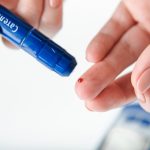Macular degeneration is the leading cause of vision loss in the United States for people over the age of 50 years. The cause of macular degeneration is unknown, it could be caused due to hereditary or environmental. At this time there is no cure for macular degeneration, though there are treatment options to help slow progression.
Macular degeneration is a condition when part of your retina called the macula is damaged. The retina is the central part of the retina. Suffering from macular degeneration can affect the central part of your vision. People rarely go fully blind from macular degeneration. Symptoms and severity vary from person to person. You are at more risk if you are over the age of 50, have a high saturated fat diet, have high blood pressure, smoke or have a family history of macular degeneration.
Types of Macular Degeneration
There are three types of macular degeneration.
Dry macular is the most common. Eighty percent of most cases of macular degeneration are dry macular type. This is when the macula thins and dries out over time. There are yellow deposits in the macula, which is usually the first sign of a problem during a routine eye exam. Dry macula can reduce central vision, reduced night vision, cause difficulty seeing in dim lighting, visual distortions, blurry vision, and difficulty reading. Loss of vision is slow and gradual. It can develop in one eye or both eyes.
Wet macular degeneration is less common, but usually much more severe. It affects roughly 10% of all macular degeneration cases. Wet macular degeneration is caused by abnormal blood vessels that grow underneath the retina and leak fluid and blood. These blood vessels and bleeding will develop a scar leading to permanent vision loss. It can cause blurriness, blind spots, general haziness, rapid or severe loss of central vision.
The third type is Stargardt Disease. This is an inherited retinal disorder. Vision loss usually starts in childhood, adolescence, or adulthood. Rarely due these cases suffer from complete blindness. It can cause vision to be hazy, have dark spots, gradual loss of vision overtime, light sensitivity, and color blindness.
Signs & Symptoms of Macular Degeneration
Signs of macular degeneration may not be noticeable right away. Since the progression can sometimes be extremely slow and gradual loss of sight is usually not the first indicator of macular degeneration. Symptoms may include worse or less clear vision. Blurry vision or hard to read fine print. It can also cause dark, blurry areas in the vision. Change in color perception. Difficulty recognizing familiar faces. Straight lines may appear wavy. Presence of drusen in the retina. Drusen is a yellow deposit found in the retina in cases of dry macular degeneration. Trouble seeing in dim lighting can also be a symptom.
Stages
There are three stages of age related macular degeneration.
- Early AMD (age related macular degeneration) usually there is no vision loss at this time, medium sized drusen found in retina.
- Intermediate AMD has some vision loss with large drusen found in the retina.
- Late AMD vision loss is noticeable.
Diagnosis of Macular Degeneration
Your eye doctor will want to take your medical history and do an eye exam to check for macular degeneration. There are other tests your doctor may want to perform as well. A visual activity test is a common eye chart test to check your distance vision if there have been any changes in your vision. Pupil dilation can be done with some eye drops that allow your eye doctor to do a close up exam of the retina. This can help them find any signs of drusen even if there are no symptoms of vision loss yet.
Fluorescein angiography is a test when wet macular degeneration is suspected. Dye is injected into a vein in the arm. As the dye passes through blood vessels in the retina photographs are taken. This can help show if there are any blood vessels leaking or bleeding.
Another test to check for wet macular degeneration is the Amsler Grid. This is a checkerboard grid, where you will look directly at the dot in the center of the grid. If any of the lines appear wavy, or missing it can determine if you are suffering from wet macular degeneration.
Treatment of Macular Degeneration
There is no cure for macular degeneration. Treatments can help with slowing progression or helping navigate with vision loss. At this time there is no treatment for dry macular degeneration or Stargardt Disease. Dry macular degeneration progresses so slowly that usually people who have this don’t reach full vision loss. Treatment may depend on a few things which could be age, overall health, medical history, extent and nature of disease, tolerance to medications, procedures, or therapies, and the expectations of the progression of the disease. Your doctor should also take your opinions and preferences into consideration as well. Treatment can slow progression, but it can’t always bring back vision loss.
If you have been diagnosed with macular degeneration your doctor may set you up with a low-vision rehabilitation specialist. This person will be able to help you adjust and cope with vision loss. As well as help you with low vision devices, tools, or techniques.
All treatment options are for wet macular degeneration. Anti-vascular endothelial growth factor drugs may be an option for treatment. Your doctor may do injections of these drugs straight into your eye. This is done after numbing drops are placed in, and with very little discomfort to the patient. These injections usually have to be on a scheduled basis regularly and overtime. These drugs help stop the growth of new blood vessels in the retina. It could take several weeks to know if this treatment method is working. It can help reduce the damage done by the leaking blood vessels, and can help effectively stabilize vision.
Another treatment option is photodynamic therapy. A doctor will inject medication into a vein in your arm. A laser will be used to close the leaking blood vessels. This may require multiple treatments. It is a less common treatment option that isn’t well known, and it may improve your vision.
Photocoagulation is when a high energy laser beam is used to destroy abnormal blood vessels in the retina. It can help stop the bleeding and reduce further damage those abnormal blood vessels could cause. The laser could cause scarring which could affect your vision. Abnormal blood vessels can regrow too.
Carrot Juice Plus has all the benefits of juiced carrots PLUS the added benefit of Rice Bran Solubles. Carrots contain vitamins that help support eye health!
Over 50 and have reduced night vision? Know the signs and symptoms for Macular Degeneration. #HealthSurgeon
Read More: 10 Best Foods For Healthy Eyes
Sources:
https://www.nei.nih.gov/learn-about-eye-health/eye-conditions-and-diseases/stargardt-disease#:~:text=Stargardt%20disease%20is%20a%20rare,vision%20until%20they’re%20adults
https://www.hopkinsmedicine.org/health/conditions-and-diseases/agerelated-macular-degeneration-amd#:~:text=Age%2Drelated%20macular%20degeneration%20(AMD)%20is%20a%20disease%20that,diet%20high%20in%20saturated%20fat
https://www.webmd.com/eye-health/macular-degeneration/age-related-macular-degeneration-overview
https://www.mayoclinic.org/diseases-conditions/dry-macular-degeneration/symptoms-causes/syc-20350375
https://www.macular.org/what-macular-degeneration
https://www.healthline.com/health/macular-degeneration#diagnosis
https://www.mcfarlandeye.com/doctors-desk-blog/2019/9/6/the-three-types-of-macular-degeneration#:~:text=There%20are%20three%20types%20of,degeneration%20found%20in%20young%20people









